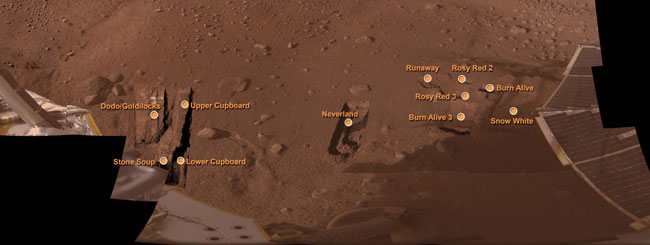Mars Lander Just Keeps Digging

NASA's Phoenix Mars Lander has spent the last few weeks digging new trenches in its landing area, looking for new materials to analyze in its instruments and examining the soil and subsurface layer of water ice.
New trenches opened recently include the "Burn Alive 3" trench in the "Wonderland" digging area in the eastern portion of the ground that Phoenix's robotic arm can reach and the "Stone Soup" trench in the "Cupboard" excavation area near the western end of the lander's workspace.
The informal names given to digging areas and samples come largely from fairy tales and folklore and are intended to aid the team's discussion of the mission.
Phoenix landed in the arctic region of Mars on May 25. The $420 million mission is digging up and analyzing samples of Martian dirt and the rock-hard subsurface layer of water ice that underlies the Martian arctic to look for clues to the potential past habitability of the red planet.
"We expect to use the robotic arm heavily over the next several weeks, delivering samples to our instruments and examining trench floors and walls to continue to search for evidence of lateral and vertical variations in soil and ice structures," said Ray Arvidson, Phoenix's "dig czar," from Washington University in St. Louis.
Phoenix is excavating one side of Burn Alive 3 down to the ice layer and plans to leave about 0.4 inches (1 centimeter) of soil above the ice on the other side of the trench. Leaving that layer, which lies just above the ice-dirt boundary, will give the Phoenix science team the vertical profile of the Martian surface they want to analyze for a sample dubbed "Burning Coals," which is intended to be the next sample delivered to Phoenix's Thermal and Evolved-Gas Analyzer (TEGA).
TEGA heats up samples in its tiny ovens and then analyzes the vapors given off to determine the composition of the material in the samples. The last sample delivered to TEGA, on Aug. 7, was to be analyzed for signs of perchlorate, a highly oxidizing substance that was detected in dirt samples by the lander's wet chemistry laboratory. Perchlorate could be a potential energy source to any microbes that may, if ever, have existed on Mars.
Breaking space news, the latest updates on rocket launches, skywatching events and more!
A sample from the Cupboard digging area may be delivered to the wet chemistry lab. Where exactly the sample would come from will depend on the results of digging in the "Upper Cupboard" area and results from the lander's thermal and electrical conductivity probe, which is located on Phoenix's robotic arm and is inserted into the icy dirt to test for the presence of salts.
Mission controllers also plan to dig up an ice-rich sample from Upper Cupboard and observe the material in the robotic arm scoop to see whether or not the sample sublimates (turns directly from ice into vapor).
In upcoming sols, or Martian days, the Phoenix team plans to scrape the "Snow White" trench and experiment with holding samples of icy dirt in the shade and sun to see if prolonged exposure to sunlight causes the material to stick to the scoop.
The stickiness of samples has been a problem in terms of delivering the dirt to TEGA, because the samples tend to stick to the scoop and clump at the screened opening to the instrument's ovens. So far, scientists are unsure what is causing the samples to clump.

Andrea Thompson is an associate editor at Scientific American, where she covers sustainability, energy and the environment. Prior to that, she was a senior writer covering climate science at Climate Central and a reporter and editor at Live Science, where she primarily covered Earth science and the environment. She holds a graduate degree in science health and environmental reporting from New York University, as well as a bachelor of science and and masters of science in atmospheric chemistry from the Georgia Institute of Technology.
